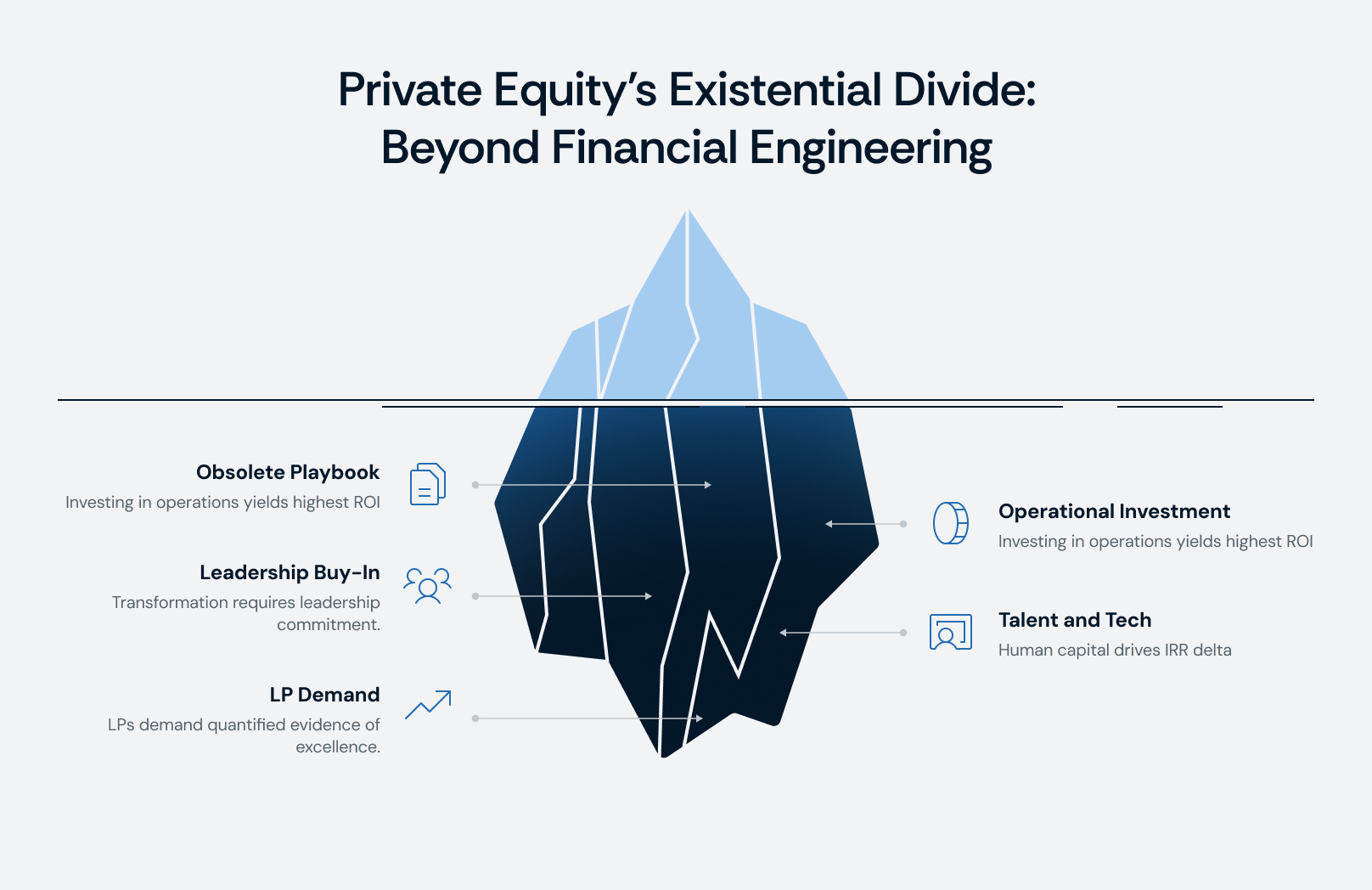Beyond Financial Engineering: How Value Creation Teams Became Private Equity's Existential Divide
- PE’s traditional playbook—leverage and multiple arbitrage—is obsolete.
- Firms with institutional-grade operating capabilities are pulling away; those without face structural decline.
- Operational investment (5–10% of management fees) yields the highest ROI in today’s market.
- True transformation requires leadership buy-in, lifecycle integration, and meaningful carry alignment.
- Winning firms embed ops from diligence to exit, with veto rights, board seats, and accountability.
- Talent and tech are now core strategy—not support. Human capital drives IRR delta.
- LPs demand quantified evidence, not claims. Operating excellence now determines capital flow.
Private equity is undergoing its most consequential shift in 50 years. Firms with sophisticated operating capabilities are outperforming peers by 2–3% IRR—compounding into hundreds of millions in additional fund value. Meanwhile, firms still clinging to financial engineering are facing LP defections, failed fundraises, and existential risk.
This isn't an overstatement. The top six PE firms now capture 60% of industry fundraising, up from just 20% five years ago—and the gap is accelerating.
The era of easy money is over. Multiple expansion, which drove more than half of PE returns from 2016–2021, has gone into reverse. Leverage costs have soared. Holding periods have stretched beyond seven years in many cases. And LPs, now laser-focused on cash-on-cash returns, have made it their top priority—a 250% rise in just three years.
In this new environment, operational excellence is no longer a differentiator—it’s the cost of entry. Firms investing in world-class value creation teams are securing their futures. Those who delay are writing their obituaries.
The Death of Financial Engineering and What Killed It
Private equity thrived for decades on a simple formula: buy at fair multiples, layer on leverage, exit at a premium. From 2010–2015, multiple expansion drove 48% of value creation. By 2016–2021, it climbed to 56%, while margin improvement was largely ignored.
That world is gone.
Entry multiples jumped 86% over the past decade—rising from 7.9x in 2013 to 14.8x by 2022—while exit multiples grew only 39%. In 2022, the dynamic reversed: firms began exiting assets at 0.5x to 1.1x lower than held valuations, ending the era of reliable markups.
Rising interest rates sealed the shift. The Fed hiked rates by 500+ basis points from 2022 to 2023. Debt costs surged. Coverage ratios for LBOs collapsed to 2.4x EBITDA, and $300B in leveraged loans come due by 2025. Debt’s share of PE capital structures has dropped from 60% to 35%.
The implications are stark. From 2016–2021, margin improvement’s contribution to value creation fell 51%. Firms coasted on multiple expansion they didn’t earn—and now, without that tailwind, their operational gaps are exposed.
Recent exit data tells the story. Held assets show margin declines of 1.2–1.4 pts, while exited assets show margin gains of 0.2–1.5 pts. That gap is the operating capability divide.
And with holding periods extending to 7+ years, the pressure compounds. A flat-EBITDA company held that long simply can’t deliver target returns—regardless of entry price or leverage. Operational improvement is no longer optional.
Cambridge Associates’ study of 1,700 deals confirms it: to hit historical returns, PE-backed companies must grow EBITDA and revenue at 11%+ annually—nearly double public company growth rates. If revenue grows 20%+, over half of deals return 3.0x+. When revenue shrinks, 58% lose money—and 40% become total losses.
In today’s math, growth is the variable that matters.
Why Operating Capabilities Became Existential Overnight
Just three years ago, strong operating teams were a competitive edge. Today, they’re a requirement for survival. Firms without them increasingly struggle to execute on their investment theses, attract top management talent, or raise capital at all.
The fundraising environment has turned sharply against undifferentiated firms. For every $3 of GP demand, there’s just $1 of LP capital—a historic imbalance. Median time to close a fund has stretched to 18.1 months, up from 11.2 two years ago. First-time funds are stalling altogether. What capital remains flows to firms with proven operating capabilities.
LPs have overhauled their evaluation playbook. Financial engineering and deal execution are now table stakes, not differentiators. Operational value creation, once a niche topic, has become a core due diligence focus. LPs want evidence—not that a firm has operating partners, but that those partners are driving results. Of the 60% of GPs claiming an operational focus, many face skepticism from the 40% of LPs who don’t see the impact.
This scrutiny is driven by a distribution crisis. LPs received just 14.6% of NAV in distributions in 2022, the lowest since the dot-com and GFC eras. In Q1 2023, distributions hit just 2.2%—the second-worst start in 30 years. At the same time, unrealized value ballooned from $1.1T in 2019 to $2.5T by 2023. LPs are funding new investments with no cash coming back, forcing them to slash PE allocations and concentrate commitments with firms that can execute.
And yet, 40% of mid-to-large cap PE funds still lack dedicated operating teams. These firms continue to rely on external consultants, reactively engaged post-close. Their deal teams underwrite value creation they can’t deliver. Their plans collect dust while management defaults to business as usual.
The consequences are predictable. These firms lose deals to operationally capable buyers with credible value creation plans. When they win, they realize post-close that the EBITDA growth they promised requires capabilities they don’t have. They turn to expensive consultants who deliver slide decks, not outcomes. Eighteen months in, with performance lagging, they fire the CEO—belatedly recognizing a gap their operating partners should have filled.
At exit, they bring decent—but unspectacular—companies to market, and buyers price them accordingly. Their MOIC hovers around 2.0x, while top-performing firms hit 2.3x or higher. Across a $2B fund, that’s a $600M difference in value—often the line between a successful fundraise and a down-round.
Meanwhile, leading firms have turned operating expertise into a defensible moat. KKR’s Capstone team, built over 25 years, now includes 100+ professionals. Bain Capital’s 115-person portfolio group leverages decades of consulting DNA. These firms have proprietary playbooks, deep talent networks, and cross-portfolio programs delivering hundreds of millions in savings.
For late entrants, the question is stark: how do you catch up when the best talent gravitates to established platforms, and building something comparable takes hundreds of millions and years of iteration?
What Separates Effective Value Creation Teams from Theater
Many firms claim operational focus—but few deliver it. The gap between marketing and execution explains why 60% of GPs say they have operations teams while only 40% of LPs see real performance impact. To break that gap, you must get several critical things right—simultaneously.
1. Align operating model to strategy
Choose between two archetypes—and match each portfolio company to the right model:
- Consultative model: Operates best in stable, well-run companies where management retains control; your ops team advises, supports, and co-owns value creation.
- Directive model: Works in turnarounds or large transformations—your ops team may intervene hands-on, take interim roles, or lead implementation.
Most successful firms adopt a hybrid approach, avoiding the trap of fitting all companies into one mode.
2. Structure matters more than size
- Centralized model (common in mega-funds) aggregates learnings, builds functional depth, supports scale, and clarifies accountability. Operating leads report to a Head of Portfolio Operations who is part of the investment committee.
- Embedded model functions in highly specialized or sector-focused funds (e.g. Vista), where ops is deeply embedded in the deal team. But this only works when volume and domain consistency justify it.
3. Embed ops across the deal lifecycle
Top-tier firms involve operating partners starting in due diligence, running operational diligence in tandem with financial strategy. They:
- Identify value levers upfront
- Define investment into ops, timelines, and capability gaps
- Make the operating thesis part of the investment case
This contrasts sharply with firms where ops join months after close, after the critical first-100-day window has passed.
4. Give ops real authority and governance
Effective value creation teams earn power, not just access. In high-functioning firms:
- Ops sits on portco boards alongside deal partners
- Ops participates in investment committee and deal vetoes on weak operational cases
- Ops signs off on operational budgets, hires, and key executive decisions
Compare that with setups where ops is sidelined—paid only salary, excluded from decision-making, and positioned as external advisors.
5. Talent mix is strategic
High-performing firms blend two profiles:
- Consultants (60%): bring rigor, frameworks, and structured problem-solving
- Operators (40%): bring execution credibility, domain experience, and authority
Consultants often rise into senior roles; operators fill specialized, functional, or interim CEO roles.
Recruit from top consulting firms and from seasoned corporate operators—this blend gives both execution credibility and analytical muscle.
6. Functional + sector strength
- Every strong ops team covers core functional domains: procurement, pricing/commercial excellence, digital & tech, human capital, and financial operations.
- Mega-funds use their scale to run cross-portfolio programs (e.g. group purchasing, tech platforms), unlocking savings across companies.
- Sector specialization sets apart funds like Vista, where deep pattern recognition in software allows faster insight, stronger playbooks, and immediate value.
7. Tailor scale to fund size
- Mega-funds ($5B+): support 50–100+ ops professionals plus external networks
- Mid-market funds ($500M–$2B): 5–15 internal operators, heavy reliance on external advisors
- Lower middle-market: 1–3 dedicated operators, activated external resources per deal
Operating budgets often hit 5–10% of management fees for large funds, and 10–20% for midsize ones.
8. Do the ROI math
For example:
- A $2B fund charging 2% in fees collects $40M/year
- If operational focus lifts IRR by 2 percentage points, and the fund winds up at 3× MOIC, that adds $120M in value
- Even if ops expenses run $80–100M over the fund life, it’s still a >1.2–1.5× return on the ops investment
That’s before considering the reputational, fundraising, and deal sourcing benefits that follow.
When all these elements align—model fit, structure, authority, talent, functional depth, and investment math—ops becomes more than “nice-to-have.” It becomes the engine of sustainable, differentiated value creation.
The Performance Case That Ended the Debate
The evidence for operating partner impact has shifted from persuasive to irrefutable.
2–3 point IRR lift
McKinsey’s analysis of 100+ post‑2020 funds shows firms with strong operational focus generate 2–3 percentage points higher IRR. On a $2B fund, that implies $120–240M in extra value—enough to shift a fund from average to top-quartile.
Value attribution flipped
In the 1980s, operations contributed ~18% of value, with leverage and multiple expansion dominating. Today, operations account for ~47%, while financial engineering shrank to 25%.
Early adopters of ops capability foresaw this shift; laggards face the fallout.
Growth ≠ optional anymore
Cambridge Associates’ study of 1,700 deals shows PE companies must grow revenue and EBITDA ~11% annually—nearly double public peer growth—to hit legacy returns. Growth is now the lever that separates winners from losers.
Deals with >20% growth often return 3×+; deals with negative growth lose money in 58% of cases.
Margins are back in play
While margin expansion was once de-emphasized, it’s now reemerging as essential. Exited assets (2022–2024) show margin gains of 0.2–1.5 points, while held assets often deteriorate by 1.2–1.4 points.
Surviving and excelling firms are the ones reversing margin declines through operations—not magic multiples.
First 100 days win or lose
Execution timing matters.
- ~89% of firms claim they make 100-day plans—but cookie-cutter checklists don’t win.
- Winners use diligence to pre-build detailed operational roadmaps, then embed ops onsite early to execute and gain management trust.
Real-world cases validate theory
- A manufacturer doubled productivity (from 30% to 60% OEE) in under 8 weeks.
- An auto supplier boosted throughput 20% in the same window.
- A telecom operator created $40M in savings from a $4.4M ops investment—a ~89% IRR.
Leadership and talent drive outcomes
Over 70% of PE-owned companies change CEOs during ownership; 75% of those are external hires. Yet many firms still under-invest in CEO planning during diligence.
CEO comp in PE averages $908K, rising to $1.43M for large companies.
Firms with strong talent models that measure human capital ROI see 28% higher returns.
Across firms, operational initiatives top the success rates:
- Operational improvements: 84%
- Top-line growth: 74%
- Governance: 73%
- Financial engineering: 68%
- Buy‑and‑build: 61%
Comp models reflect the stakes
Leading funds often allocate $25–50M annually to operations.
On a $5B fund, a 2% IRR boost with a 3× MOIC generates $300M in value—even before factoring in fundraising, reputation, or deal sourcing benefits.
How Winners Pull Away While Losers Spiral Downward
The divergence between operationally sophisticated and deficient PE firms is now so stark that clear patterns have emerged. These gaps are widening, and for laggards, the consequences are becoming existential.
Winning Firms: Key Characteristics
- Scaled Operating Teams: Winners have sizable teams of 25–115+ professionals based on fund size. These teams are integrated throughout the investment lifecycle, from pre-LOI diligence through exit.
- Operational Veto Power: Operating leaders sit on investment committees and can veto deals lacking viable operational theses.
- Governance Authority: Operating partners sit on boards, hold equal decision rights to deal teams, and own execution accountability.
Examples:
- KKR: Capstone team has saved $700M+ via procurement programs.
- Blackstone: Serves 250+ companies, leveraging scale to optimize shared resources.
- Vista Equity: Specializes in software with proprietary playbooks refined across 90+ deals.
- EQT: Dominates digital transformation in Europe.
Winning firms showcase operating capabilities as a strategic fundraising differentiator—quantifying EBITDA impacts, spotlighting ops leaders in LP meetings, and demonstrating operating team growth.
Losing Firms: Common Patterns
- Minimal or Cosmetic Ops Teams: Often 1–2 operating partners hired for optics.
- Delayed Engagement: Ops professionals aren’t involved in diligence or early transformation.
- No Economic Alignment: Salary-only comp with no carry; no board presence or decision authority.
The Result:
- Value creation plans go unexecuted.
- Consultants step in post-performance issues, often too late.
- CEO replacements are reactive, expensive, and destabilizing.
Fundraising Penalties:
- Median time-to-close: 18.1 months (up from 11.2).
- LPs increasingly ask specific diligence questions: team size, ops involvement in diligence, EBITDA impact attribution, carry participation.
- Firms that underinvest in ops face scrutiny, skepticism, and stalled closes.
Warning Signs and Strategic Errors
- Ops teams are subordinated to deal teams.
- No ops involvement pre-close.
- No operational thesis during underwriting.
- Compensation structure excludes carry.
- Operating partners are hired late, with unclear mandates or inadequate tools.
The Structural Shift
- Market Dynamics Have Changed:
- Multiple compression, high debt costs, and longer holds are permanent shifts.
- Future returns depend on real operational improvements, not financial engineering.
- Fundraising is Now Power Law-Driven:
- The top six firms (Blackstone, KKR, Apollo, Carlyle, TPG, Blue Owl) captured ~60% of all industry capital in 2024.
- LPs are reallocating structurally toward firms with proven ops track records.
Why Many Efforts Fail
- Wrong Model: Consultative when directive is needed or vice versa.
- Wrong Hires: Prestige over execution capabilities.
- Wrong Incentives: No carry, weak integration.
- Wrong Timing: Building late under fundraising pressure, leading to years-long delays in ROI.
Bottom Line: In the current PE environment, operational sophistication is no longer optional. It's the defining trait separating winners from those facing irrelevance.

Why The Future Guarantees a Wider Chasm
The divide between firms with real operational strength and those without is becoming structural—not cyclical. Several forces ensure the gap won’t just persist, it will widen.
1. Debt is costlier, not easier to wield
Interest rates have jumped. Debt now burdens portfolio companies rather than amplifying returns. Firms that can’t improve cash flow and margins risk covenant stress or distress.
2. Multiple expansion is dead as a strategy
Entry multiples have risen dramatically, but exit multiples haven’t kept pace. Those who bet on continued multiple expansion are now exposed. The only way forward is real EBITDA growth and operational improvement.
3. LPs demand distributions—now
LPs have shifted expectations. Distributions matter more than paper gains. And with $2.5T in unrealized value trapped across PE, capital is flowing to firms that can deliver. Those that can’t will lose allocations permanently.
4. Diligence standards have changed forever
LPs no longer accept ops as a footnote. They demand evidence: team size, track record, initiative outcomes, compensation alignment. Firms without data-driven ops architectures are increasingly disqualified before the race begins.
5. Technology accelerates divergence
AI, automation, and analytics are scaling operational insights across portfolios. Firms with the technical backbone will spot value levers earlier and execute faster. Those without capacity to scale through tech will fall behind.
6. Sector specialization eats generalist advantage
Specialist firms (e.g., software, industrials) are outperforming generalists. LPs now expect sector depth. Without that, generalists struggle to match the speed, insight, and tools of domain-focused operators.
7. Longer holds magnify the gap
Median holding periods are now ~5.8 years. Without operational engagement through that stretch, performance deteriorates. Longer holds reward firms with consistent, value-driving ops talent—not those banking on exits.
8. Dynamics become self-reinforcing
Winning teams attract better deals, talent, and capital. They reinvest into ops, compounding advantage. Laggards lose deals, underperform, and see limited capital to build capabilities—they fall further behind.
9. Talent dynamics lock in advantage
Top operating talent crowds toward established, empowered platforms. Late entrants offering vague roles or weak economics can’t lure the caliber needed to catch up. It’s not just hiring; it’s how you engage and empower them.
10. The catch-up cost is steep
Building a 50–100 person ops engine is expensive—$25–50M+ annually. Mid-market firms already stretched can’t just “bolt on” that capability overnight. Delay deepens the divide, but building capabilities without capital is also risky.
The Imperative and Path Forward
Private equity is at a generational inflection point. The old model—financial engineering through leverage and multiple arbitrage—no longer delivers. The firms that embrace operational excellence will thrive. Those that delay or underinvest face decline, irrelevance, or failure.
This is no longer about marginal improvement.
A 2–3% IRR gap—$120–240 million on a $2B fund—is the difference between median and top-quartile performance. That differential shapes LP sentiment, fundraising success, and firm longevity.
Operational investment is now the best use of capital.
Allocating 5–10% of management fees to ops may seem steep—until compared with the ROI: access to better deals, stronger exits, and LP preference. Sophisticated ops teams are capturing 60%+ of industry fundraising.
Leadership must drive the shift.
Founders who succeeded in the financial engineering era must embrace cultural change: empowering operating partners, integrating them in ICs, sharing carry, and aligning governance structures.
Winning teams are built, not bought.
Hire from top consulting firms (EM+), blend with former operators, and invest in a talent partner to build an executive bench. Aim for 0.75–1.25 ops professionals per investment lead. Prioritize functional depth—procurement, pricing, tech, talent, finance.
Lifecycle integration is non-negotiable.
Operating partners must be embedded from diligence to exit—with board roles, veto rights, 100-day ownership, and exit preparation responsibilities. Surface-level involvement won't deliver real results.
Align incentives—especially carry.
Salary-only signals support staff. Carry participation (1–3% per OP) ensures true alignment with fund outcomes and demonstrates value to LPs and recruits alike.
Model structure to fund strategy.
Centralized teams work best for generalist funds; embedded models fit deep sector specialists. Avoid one-size-fits-all. Structure must match transaction volume and portfolio needs.
Systematize without rigidity.
Create repeatable processes—diligence playbooks, KPI dashboards, 100-day plan templates—but remain adaptable to each portfolio company's context.
Talent is strategy.
Treat CEO and C-suite hiring like deal diligence. Build search networks proactively. With 70%+ CEO turnover in PE, human capital isn't optional—it’s central to return generation.
Go digital or fall behind.
Invest in AI, automation, and shared tech infrastructure. EBITDA lifts of 5–25% justify it. Technology fluency will separate future winners from analog holdouts.
LPs know what to ask now.
"How many ops professionals do you have?" "Are they on the IC?" "What’s their carry?" "Can you quantify EBITDA impact?" Firms must answer these clearly—with numbers, not narratives.
For late movers: act fast, start small, show results.
Begin with 2–3 high-quality, empowered ops hires. Integrate them immediately. Use wins in fundraising. Be transparent with LPs about the journey and committed to real investment.
For some, the honest move may be exit.
If building ops depth isn't viable—because of resources, culture, or time—consider strategic partnerships or managed wind-downs. Better to act early than fade slowly.
The fork in the road is here.
Operational excellence is no longer a differentiator—it’s a requirement. The firms that adapt will define the next era of private equity. Those that don’t won’t be here to see it.








